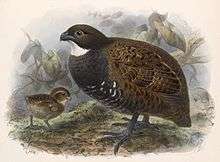Wood quail
The wood quails are birds in the genus Odontophorus of the New World quail family, which are residents in forests in the Americas.[1] The core range of the genus is centered in the lowlands and foothills of the northern Andes of Colombia and the mountain ranges of Central America; however, some species occur elsewhere in tropical and subtropical South America.
| Wood quail | |
|---|---|
 | |
| Odontophorus leucolaemus | |
| Scientific classification | |
| Kingdom: | Animalia |
| Phylum: | Chordata |
| Class: | Aves |
| Order: | Galliformes |
| Family: | Odontophoridae |
| Subfamily: | Odontophorinae |
| Genus: | Odontophorus Vieillot, 1816 |
| Species | |
|
See species list | |
These are shy species, and as a consequence are amongst the most difficult galliform birds to study or even observe. The best chance of seeing wood quail is at dawn or dusk, when they may feed at the side of a road or on a forest track in family groups up to 12 birds. Nevertheless, when protected, they can become surprisingly tame, as has been shown at Paz de las Aves near Mindo, Ecuador, with the dark-backed wood quail.
Wood quail are 22–30 cm long, dumpy, short-tailed, stout-billed partridge-like birds with a bushy crest. The upper parts are dark brown, and the under parts are black, grey, brown, or rufous. Some species have a striking black and white throat or facial markings. The sexes are similar, but in some species, the female has a duller-coloured crest, and in others the under parts are more rufous or grey than in the male. The advertising calls are loud and distinctive duets consisting of repeated phrases, and are often the only indication that wood quail are present.
For most wood quail, information has mainly come from specimens, and breeding behaviour and habits are little known. The majority of species, including the relatively widespread spotted wood quail have never had their nests described.
Those species for which the feeding habits are known forage on the ground, scratching at the soil for seeds, fallen fruit, and insects. Wood quail are typically shy and wary; they normally make good their escape on foot, but if startled, explode into a short, fast flight into dense cover.
All wood quail species have been adversely affected by hunting and, in particular, rampant deforestation. Several species with restricted ranges are now considered threatened.
Species
| Image | Common name | Name | Distribution |
|---|---|---|---|
.jpg) | Marbled wood quail | Odontophorus gujanensis | Bolivia, Brazil, Colombia, Costa Rica, Ecuador, French Guiana, Guyana, Panama, Peru, Suriname, and Venezuela. |
.jpg) | Spot-winged wood quail | Odontophorus capueira | Brazil, Argentina and Paraguay, and formerly in Uruguay |
| Black-eared wood quail | Odontophorus melanotis | Honduras, Nicaragua, Costa Rica and Panama. | |
| Rufous-fronted wood quail | Odontophorus erythrops | Colombia and Ecuador | |
| Black-fronted wood quail | Odontophorus atrifrons | Colombia and Venezuela | |
.jpg) | Chestnut wood quail | Odontophorus hyperythrus | Colombia. |
.jpg) | Dark-backed wood quail | Odontophorus melanonotus | Colombia and Ecuador |
| Rufous-breasted wood quail | Odontophorus speciosus | Bolivia, Ecuador, and Peru. | |
| Tacarcuna wood quail | Odontophorus dialeucos | Colombia and Panama. | |
| Gorgeted wood quail | Odontophorus strophium | Colombia. | |
| Venezuelan wood quail | Odontophorus columbianus | Venezuela | |
| Black-breasted wood quail | Odontophorus leucolaemus | Costa Rica and Panama | |
| Stripe-faced wood quail | Odontophorus balliviani | southern Peru and Bolivia | |
| Starred wood quail | Odontophorus stellatus | Bolivia, Brazil, Ecuador, and Peru. | |
.jpg) | Spotted wood quail | Odontophorus guttatus | Central America from southern Mexico to western Panama. |
References
- Johnsgard, "The American Wood Quails Odontophorus" World Pheasant Association Journal 4 (1979), pp. 93–99.
- Hilty, Birds of Venezuela, ISBN 0-7136-6418-5
- Madge and McGowan,Pheasants, Partridges and Grouse ISBN 0-7136-3966-0
- Stiles and Skutch, A guide to the birds of Costa Rica ISBN 0-8014-9600-4